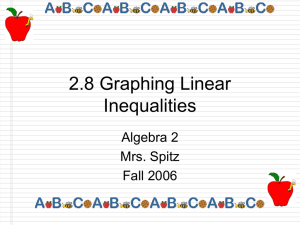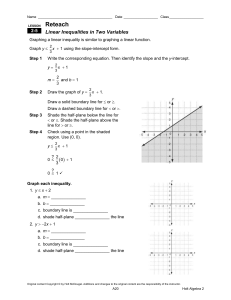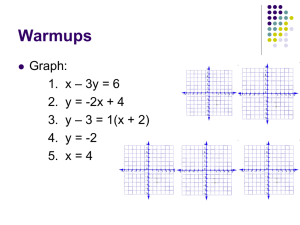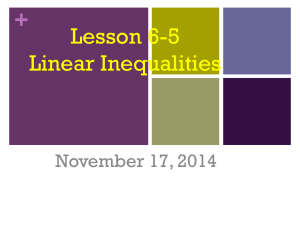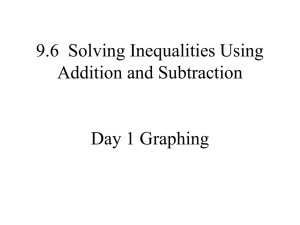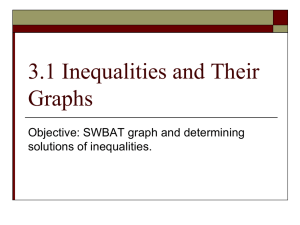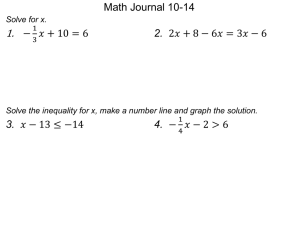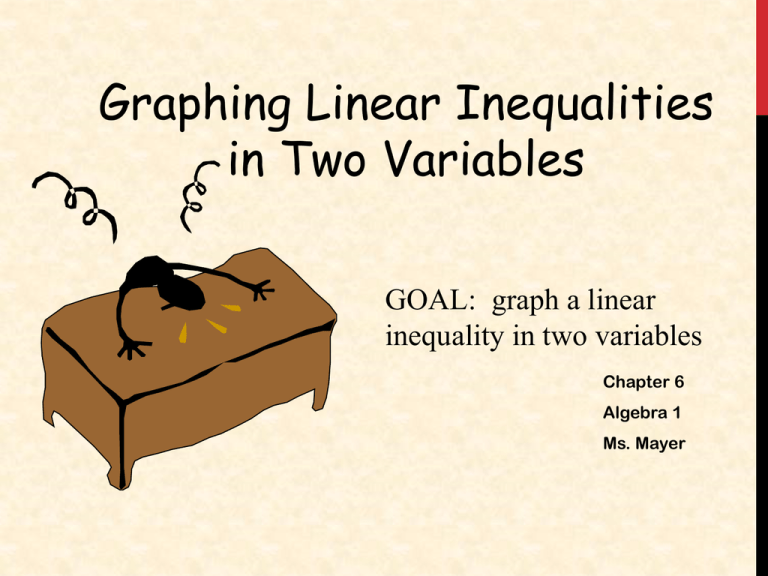
Graphing Linear Inequalities
in Two Variables
GOAL: graph a linear
inequality in two variables
Chapter 6
Algebra 1
Ms. Mayer
Expressions of the type x + 2y ≤ 8 and 3x – y > 6
are called linear inequalities in two variables.
A solution of a linear inequality in two variables is
an ordered pair (x, y) which makes the inequality
true.
Copyright © by Houghton Mifflin Company, Inc. All rights
reserved.
2
Example: (1, 3) is a solution to x + 2y ≤ 8
since (1) + 2(3) = 7 ≤ 8.
Using What We Know
Sketch a graph of x + y < 3
Step 1: Put into
slope intercept
form
y <-x + 3
Step 2: Graph the
line
y = -x + 3
Less than means to the
left or below.
To check it, pick any point that
is not on the line. (0,0) is an
easy point to use.
x+y<3
Substitute 0 for x and y.
0+0<3
0<3
Decide if this is true or false.
Is 0 less than 3?
If it is true, you shade on the
same side of the line of the point
you picked.
If it is false, you shade on the
opposite side of the line where
the point you picked lies.
Graphing Linear Inequalities
The graph of a linear inequality in two variables is the graph of
all solutions of the inequality.
The boundary line of the inequality divides the coordinate plane into two halfplanes: a shaded region which contains the points that are solutions of the
inequality, and an unshaded region which contains the points that are not.
GRAPHING A LINEAR INEQUALITY
The graph of a linear inequality in two variables is a half-plane. To
graph a linear inequality, follow these steps.
STEP 1 Graph the boundary line of the inequality. Use a dashed
line for < or > and a solid line for or .
STEP 2 To decide which side of the boundary line to shade, test a
point not on the boundary line to see whether it is a solution
of the inequality. Then shade the appropriate half-plane.
To graph the solution set for a linear inequality:
1. Graph the boundary line.
2. Select a test point, not on the boundary line, and
determine if it is a solution.
Copyright © by Houghton Mifflin Company, Inc. All rights
reserved.
6
3. Shade a half-plane.
Graphing a Linear Inequality
Sketch a graph of y 3
Graphing an Inequality in Two Variables
Graph x < 2
Step 1: Start by graphing
the line x = 2
Now what points
would give you less
than 2?
Since it has to be x < 2
we shade everything to
the left of the line.
Graph a) y < –2 and b) x 1 in a coordinate plane.
SOLUTION
Graph the boundary line y = –2.
Use a dashed line because y < – 2.
Graph the boundary line x = 1.
Use a solid line because x 1.
Test the point (0, 0).
Test the point (0, 0).
Because (0, 0) is not a solution
of the inequality, shade the
half-plane below the line.
Because (0, 0) is a solution of
the inequality, shade the halfplane to the left of the line.
Some Helpful Hints
•If the sign is > or < the line is
dashed
•If the sign is or the line will be
solid
When dealing with just x and y.
•If the sign > or the shading
either goes up or to the right
•If the sign is < or the shading
either goes down or to the left
When dealing with slanted lines
•If it is > or then you shade above
•If it is < or then you shade below
the line
The set of all solutions of a system of linear inequalities
is called its solution set.
To graph the solution set for a system of linear
inequalities in two variables:
1. Shade the half-plane of solutions for each
inequality in the system.
Copyright © by Houghton Mifflin Company, Inc. All rights
reserved.
12
2. Shade in the intersection of the half-planes.
Example: Graph the solution set for the system of
linear inequalities: 2 x 3 y 12
2 x 3 y 6
y
-2x + 3y ≥ 6
Graph the two half-planes.
2
The two half-planes do not
intersect;
therefore, the solution set is
the empty set.
x
2
Copyright © by Houghton Mifflin Company, Inc. All rights
reserved.
13
2x – 3y ≥ 12
EXAMPLE 1
Which ordered pair is a solution of
5x - 2y ≤ 6?
A.
B.
C.
D.
(0, -3)
(5, 5)
(1, -2)
(3, 3)
EXAMPLE 2
Graph the inequality x ≤ 4 in a coordinate
plane.
HINT: Remember HOY VEX.
Decide whether to
use a solid or
dashed line.
Use (0, 0) as a
test point.
Shade where the
solutions will be.
y
5
x
-5
-5
5
EXAMPLE 3
Graph 3x - 4y > 12 in a coordinate plane.
Sketch the boundary line of the graph.
Find the x- and
y-intercepts and
plot them.
y
5
Solid or dashed
line?
Use (0, 0) as a
test point.
Shade where the
solutions are.
x
-5
-5
5
EXAMPLE 4:
USING A NEW TEST POINT
Graph y < 2/5x in a coordinate plane.
Sketch the boundary line of the graph.
Find the x- and y-intercept and plot them.
5
Both are the origin!
y
•Use the line’s slope
to graph another point.
Solid or dashed
line?
Use a test point
OTHER than the
origin.
Shade where the
solutions are.
-5
-5
x
5
HOMEWORK

